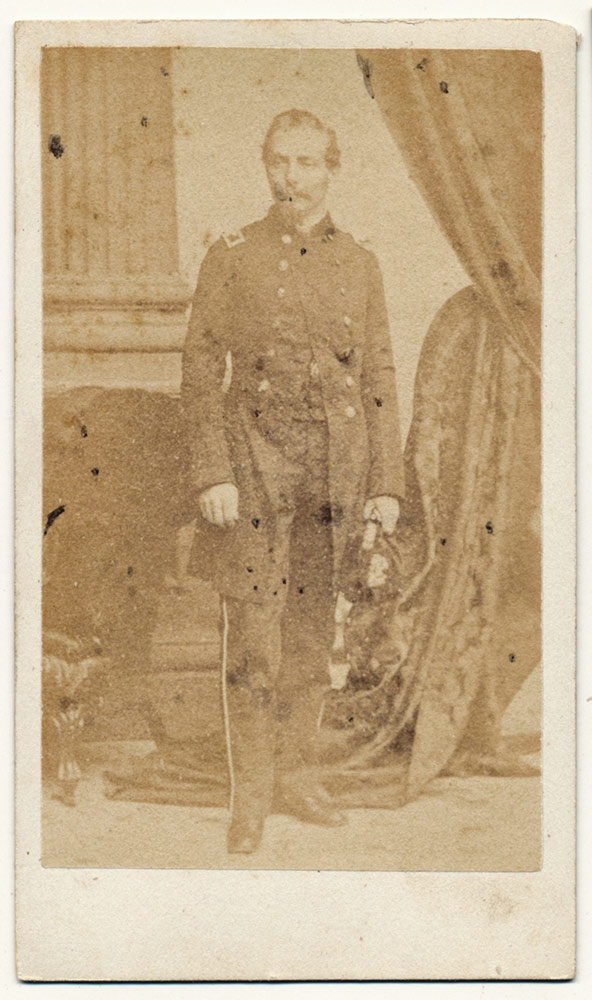site search
online catalog
FULL STANDING VIEW OF CONFEDERATE GENERAL P. G. T. BEAUREGARD

Hover to zoom
$60.00 SOLD
Quantity Available: None
Item Code: 259-51
Image shows General P. G. T. Beauregard standing between a column and a draped curtain. He wears a dark double-breasted frock coat with shoulder straps and matching dark trousers with a light colored thin leg stripe. He holds his forage cap in his left hand.
Image has good clarity but the contrast is very light. Mount is good but the paper has several scattered dark spots of discoloration.
There is no photographer’s imprint on the reverse.
Pierre Gustave Toutant Beauregard was born at the "Contreras" sugar-cane plantation in St. Bernard Parish, Louisiana, about 20 miles outside New Orleans, to a French Creole family. Beauregard attended New Orleans private schools and then went to a "French school" in New York City. During his four years in New York, beginning at age 12, he learned to speak English, as French had been his first and only language in Louisiana.
He then attended the United States Military Academy at West Point, New York. One of his instructors was Robert Anderson, who later became the commander of Fort Sumter and surrendered to Beauregard at the start of the Civil War. He graduated second in his class in 1838 and excelled both as an artilleryman and military engineer. His Army friends gave him many nicknames: "Little Creole", "Bory", "Little Frenchman", "Felix", and "Little Napoleon".
During the Mexican War, Beauregard served as an engineer under General Winfield Scott. He was appointed brevet captain for the battles of Contreras and Churubusco and major for Chapultepec, where he was wounded in the shoulder and thigh. He was one of the first officers to enter Mexico City.
Beauregard returned from Mexico in 1848. For the next 12 years, he was in charge of what the Engineer Department called "the Mississippi and Lake Defenses in Louisiana." Much of his engineering work was done elsewhere, repairing old forts and building new ones on the Florida coast and in Mobile, Alabama. He also improved the defenses of Forts St. Philip and Jackson on the Mississippi River below New Orleans. He worked on a board of Army and Navy engineers to improve the navigation of the shipping channels at the mouth of the Mississippi. President Pierce appointed Beauregard as superintending engineer of the U.S. Custom House in New Orleans.
During his service in New Orleans, Beauregard became dissatisfied as a peacetime officer. He briefly entered politics as a reform candidate for mayor of New Orleans in 1858, where he was promoted by both the Whig and Democratic parties to challenge the Know Nothing party candidate. Beauregard was narrowly defeated.
Beauregard obtained an appointment as superintendent of the U.S. Military Academy on January 23, 1861. His orders were revoked and he relinquished the office after only five days when Louisiana seceded from the Union.
As a Confederate General Beauregard commanded the defenses of Charleston, South Carolina, for the start of the Civil War at Fort Sumter on April 12, 1861. Three months later he was the victor at the First Battle of Bull Run.
Beauregard commanded armies in the Western Theater, including the Battle of Shiloh in Tennessee, and the Siege of Corinth in Northern Mississippi. He returned to Charleston and defended it from repeated naval and land attacks in 1863. His arguably greatest achievement was saving the city of Petersburg, Virginia, and thus also the Confederate capital of Richmond, from assaults by overwhelmingly superior Union Army forces in the June of 1864. However, his influence over Confederate strategy was marred by his poor relationships with Confederate President Jefferson Davis and other generals. In April 1865, Beauregard and his commander, General Joseph E. Johnston, convinced Davis and the remaining cabinet members that the war needed to end, and the majority of the remaining confederate armies were surrendered to Sherman.
Following his career, Beauregard was one of the few wealthy Confederate veterans because of his role in promoting the Louisiana Lottery. He died in 1893 and is buried in New Orleans in the tomb of the Army of the Tennessee. [ad] [ph:L]
~~~~~~~~~~~~~~~~~~~~~~~~~~~~~~~~~~~
THIS ITEM, AS WITH ALL OTHER ITEMS AVAILABLE ON OUR WEB SITE,
MAY BE PURCHASED THROUGH OUR LAYAWAY PROGRAM.
CLICK HERE FOR OUR POLICIES AND TERMS.
THANK YOU!
Inquire About FULL STANDING VIEW OF CONFEDERATE GENERAL P. G. T. BEAUREGARD
Most Popular
Historical Firearms Stolen From The National Civil War Museum In Harrisburg, Pa »
Theft From Gravesite Of Gen. John Reynolds »
Selection Of Unframed Prints By Don Troiani »
Fine Condition Brass Infantry Bugle Insignia »
featured item
FANTASTIC FRAMED DRAWING OF THE BATTLE OF DRAINSVILLE DONE BY GETTYSBURG CARTOGRAPHER EMMOR B. COPE
This wonderful and detailed drawing shows the meeting engagement on December 20, 1861 between a brigade of Pennsylvania Reserve regiments under Brig. Gen. E. O. C. Ord and a mixed Confederate force led by Gen. J. E. B. Stuart. The scene was drawn by… (1054-2733). Learn More »


